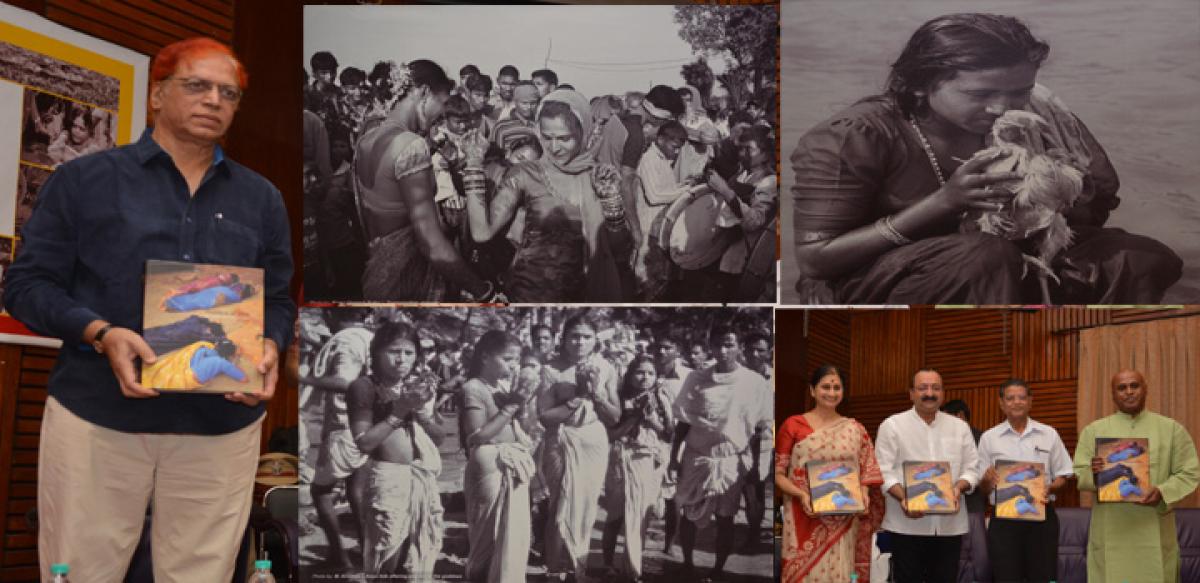Live
- Rekha gets emotional as she shares a heartfelt moment with Big B's grandson Agastya Nanda
- Senior Cong leader EVKS Elangovan passes away in Chennai
- CID's Counter Intelligence raids multiple places in J&K’s Anantnag, Kulgam districts
- India's growth on resilient trajectory, equity markets in consolidation phase
- KJo on 23 years of ‘Kabhi Khushi Kabhie Gham’: One of those pinch me moments
- WPL 2025 auction: Nandini, Kamalini set to be most sought-after names
- MP CM to inaugurate Sarsi resort in Shahdol, 200-bed hospital in Mauganj today
- TGPSC makes arrangements for Group-2 exams to be held tomorrow
- WPL 2025 Auction: When and where to watch, date, time, live streaming, venue
- Japan: Citizens protest US military-related sexual violence
Just In

A labour of love, he calls it. B Narsing Rao, filmmaker and chief editor of the coffee table book ‘Goddess of Folk’ speaks to The Hans India on tracking down photographs and researching the Medaaram Sammakka Saralamma Jatara
A labour of love, he calls it. B Narsing Rao, filmmaker and chief editor of the coffee table book ‘Goddess of Folk’ speaks to The Hans India on tracking down photographs and researching the Medaaram Sammakka Saralamma Jatara
When was the idea of bringing out a coffee table book on Medaaram Sammakka Saralamma Jathara conceived?
The idea of documenting the jathara first came to my mind a decade ago when I had inaugurated a photo exhibition of Rama Veereash Babu on the same theme. After the formation of TRS government and with the announcement of celebrating the jathara in a big way was made, I floated the idea to B V Papa Rao, trustee of Kakatiya Heritage Trust. I was nurturing this idea for over a decade.
There is published material on the jathara. What is new in the coffee table book?
The novelty of the book lies in the 160 photographs that span a period of 60 years. Some photos date back to 1955 and capture the tribal rituals in rustic background. This book should be viewed as an ethnographic and anthropological work and can make it to any university in India and abroad.
A lot of research work has gone into the work. Several people such as Nanumasa Swamy, P Krishnamurthy, Anjani Devi and others worked hard. The book traces the jathara to a time when just 5,000 people came together. Today, two crore people make it to the Medaaram Sammakka Saralamma Jathara
Today, if one were to take pictures of the jathara, it would be impossible to capture the ethnic background as the tribals are lost in the crowd. In a radius of 10 km you have close to 60 lakh people whereas in the 50s there were just tribals. Shooting a documentary now does not make sense.
How did you manage to track down photographers who took pictures decades ago and how difficult was it to decide on which to choose?
To start with we had photographs of Rama Veereash. We researched on people who documented the jathara and reached out to them but I must admit the restoration work done by Raj Kumar was the best thing about the project.
We rummaged through 7,000-8,000 photographs. Veereash himself had taken 3,000 photographs. We finally zeroed on 160 photographs of 20 photographers.
Majority of the photographs are in black and white. We also understand that colour photographs too were converted into black and white.
We did it to capture the ethnic background as well as to keep the nostalgia value intact. Clarke Wordswick, photo-historian and documentary filmmaker had advised me long ago to use deotone. The effort did not go in vain as we have been not only been able to restore almost shattered photographs but give a new lease of life. We also have added a few colour photographs in 15-20 pages in the book.
Who should read the book?
The book should interest anyone with a sense of history, who values the past, someone who wants to know about the tribal Koya community. Tribals from Telangana, Andhra Pradesh, Chhattisgarh, Orissa and even from Manali in the North India make it to the jathara. There is a 42 page text too that traces the history of the jathara and complements the photographs.
Tell us about the oldest photographs
The oldest photographs that adorn the book were taken by Late M Krishna, former MLA of Mulug that date back to 1955. He had gone to the USA on a scholarship and had returned with an 8 mm camera. We were fortunate to get the photographs from his family members. Some photos were in a very bad state but now are restored for posterity.

© 2024 Hyderabad Media House Limited/The Hans India. All rights reserved. Powered by hocalwire.com







